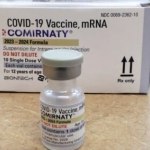04 March 2024
Deep brain stimulation, or DBS, is an experimental treatment that involves having an electrical device placed in the brain.
The treatment gives patients' brains targeted electrical impulses.
Researchers say DBS could help some of the nearly 3 million Americans with depression that resists other treatments. It is approved for conditions like Parkinson's disease and epilepsy. Many doctors and patients hope it will become more widely available for depression.

Emily Hollenbeck stands for a portrait at the American Museum of Natural History's Rose Center in New York on Jan. 12, 2024. (AP Photo/Mary Conlon)
Recent research suggests gains are possible and more research is planned. However, two earlier studies showed no gains using DBS for depression. Those results have slowed the treatment that involves a brain operation. Some scientists continue to raise concerns about DBS.
The U.S. Food and Drug Administration (FDA) has agreed to speed up its study of Abbott Laboratories' request to use its DBS devices for treatment-resistant depression.
"Nothing else was working"
Emily Hollenbeck lived with severe depression. She compared it to a black hole. She felt as though her arms and legs could barely move. She knew both of her parents had taken their lives and that her condition was dangerous.
Hollenbeck, who grew up poor and sometimes homeless, suffered from signs of depression as a child. In college, after her father's suicide in 2009, she had her first period of major depression. Another happened while she was working. She was concerned she would lose her teaching job and become poor again. She went to the hospital.
"I ended up having sort of an on-and-off pattern," she said. Medication helped her for a while.
She was able to earn a doctoral degree in psychology although she lost her mom in her final year of graduate school. But the depression stayed with her. At times, she said, she thought about ending her life.
She was willing to try something extreme.
Her doctor then told her about DBS three years ago.
"Nothing else was working," she said.
She became one of a few hundred people to have her depression treated with DBS.
Hollenbeck is part of ongoing research at Mount Sinai West medical center in New York City. Her brain operation took place while she was sedated but still awake. Dr. Brian Kopell directs Mount Sinai's Center for Neuromodulation. He placed thin metal electrodes in the part of her brain believed to control emotional behavior and is thought to be involved in feelings of sadness.
The thin metal electrodes are connected by wires to a device placed under the skin of her chest. The device controls the electrical impulses sending current to her brain.
Doctors involved in DBS say the impulses help because the brain uses electricity to send signals.
In normal brains, Kopell said, electrical activity spreads through the brain unblocked to all areas. In depression, he said, the brain's emotional signals get blocked. He compared the problem to dancing. He said DBS seems to "unstick the circuit," permitting the brain to do what it normally would. A circuit is the path unblocked electrical current takes.
Hollenbeck said the effect on her was almost immediate.
"The first day after surgery, she started feeling a lifting of that negative mood, of the heaviness," said her psychiatrist, Dr. Martijn Figee.
For Hollenbeck, the biggest change was finding pleasure in music again.
She wishes her treatment had been available for her parents.
The treatment's history
DBS research has continued for at least 20 years. Brain expert Dr. Helen Mayberg led early research that was called promising. But large studies launched more than 12 years ago saw no difference in treated and untreated groups.
Dr. Katherine Scangos is a psychiatrist at the University of California, San Francisco. She is also researching DBS and depression. She said there could be two reasons for the major studies showing no effect.
She said one reason was that the treatment was not "personalized" for each individual in the two studies. The second was that researchers looked at outcomes over just a few weeks.
Recent research has shown more promising results for depression. A 2022 study said that on average 60 percent of depression patients showed improvement with DBS. A study from 2023 said that after six months of targeted DBS treatment, 90 percent of subjects showed improvements. Seventy percent were no longer considered medically depressed.
Treatments being tested by teams today target individual patients more closely. The team at Mount Sinai, for example, is using brain imaging to find the right place to put electrodes in the brain.
Mayberg is also with Mount Sinai. She said, "Everybody's brain is a little different, just like people's eyes are a little further apart or a nose is a little bigger or smaller."
Looking ahead
Medical devices manufacturer Abbott Laboratories is launching a large clinical trial on patients this year, ahead of a possible decision by the FDA.
Scangos said: "I'm hoping we will have approval within a short time."
But some doctors have concerns. They point to possible dangers of having a brain operation, which include bleeding, stroke and infection.
Dr. Stanley Caroff is a professor of psychiatry at the University of Pennsylvania. He said scientists do not know the exact pathways or systems in the brain that produce depression. That makes it difficult to send the impulses to the right place.
"I believe from a psychiatric point of view, the science is not there," he said of DBS for depression.
Moving forward
Hollenbeck said DBS has not cured her. She still takes medicines for depression and needs ongoing care.
She recently visited Mayberg of Mount Sinai in her office and discussed recovery. "It's not about being happy all the time," Mayberg told her. "It's about making progress."
Researchers are studying the progress patients make. Recent research by Mayberg and others published in Nature said scientists can study brain activity to see how someone is doing at any given time.
Study subjects can provide data from their homes about how they feel. Subjects answer questions and send data from their devices to researchers. They also send videos where researchers can observe speech and facial movements.
Additionally, patients go to Mount Sinai so researchers can collect more information about their body movements. Hollenbeck, for example, is showing faster movements as her condition improves.
The data gained, combined with other information like life events, records how she is doing. This helps guide doctors' decisions about treatment, like increasing the amount of electricity used — which they did once.
Hollenbeck showed AP the scars on her chest and head where doctors had placed the DBS devices. To her, they were signs of how far she had come.
She added, "...I'm able to see and remember, even on a bodily level, that I'm going to be OK."
I'm Gena Bennett. And I'm Gregory Stachel.
Laura Ungar reported this story for The Associated Press. Gregory Stachel adapted it for VOA Learning English.
______
Words in This Story
impulse – n. a small amount of energy that moves from one area to another
pattern – n. the regular and repeated way in which something happens or is done
psychology – n. the science or study of the mind and behavior
sedate – v. to give (a person or animal) drugs that cause relaxation or sleep
electrode – n. one of the two points through which electricity flows into or out of a battery or other device
chest – n. the front part of the body between the neck and the stomach
negative – adj. harmful or bad: not wanted
psychiatry – n. a branch of medicine that deals with mental or emotional disorders
clinical trial – n. a research study in which a medical treatment is carefully tested on people to find out how safe and effective it is











